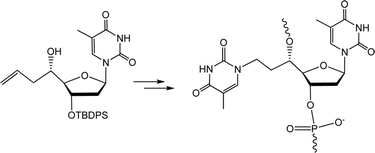Nucleic acid secondary structures containing the double-headed nucleoside 5′(S)-C-(2-(thymin-1-yl)ethyl)thymidine
Abstract
Oligodeoxynucleotides containing the double-headed

* Corresponding authors
a
Nucleic Acid Center, Department of Chemistry and Physics, University of Southern Denmark, Denmark
E-mail:
pon@ifk.sdu.dk
Fax: +45 66158780
Tel: +45 65502565
b Department of Chemistry, Kurukshetra University, India
Oligodeoxynucleotides containing the double-headed

 Please wait while we load your content...
Something went wrong. Try again?
Please wait while we load your content...
Something went wrong. Try again?
C. Andersen, P. K. Sharma, M. S. Christensen, S. I. Steffansen, C. M. Madsen and P. Nielsen, Org. Biomol. Chem., 2008, 6, 3983 DOI: 10.1039/B810930C
To request permission to reproduce material from this article, please go to the Copyright Clearance Center request page.
If you are an author contributing to an RSC publication, you do not need to request permission provided correct acknowledgement is given.
If you are the author of this article, you do not need to request permission to reproduce figures and diagrams provided correct acknowledgement is given. If you want to reproduce the whole article in a third-party publication (excluding your thesis/dissertation for which permission is not required) please go to the Copyright Clearance Center request page.
Read more about how to correctly acknowledge RSC content.
 Fetching data from CrossRef.
Fetching data from CrossRef.
This may take some time to load.
Loading related content
